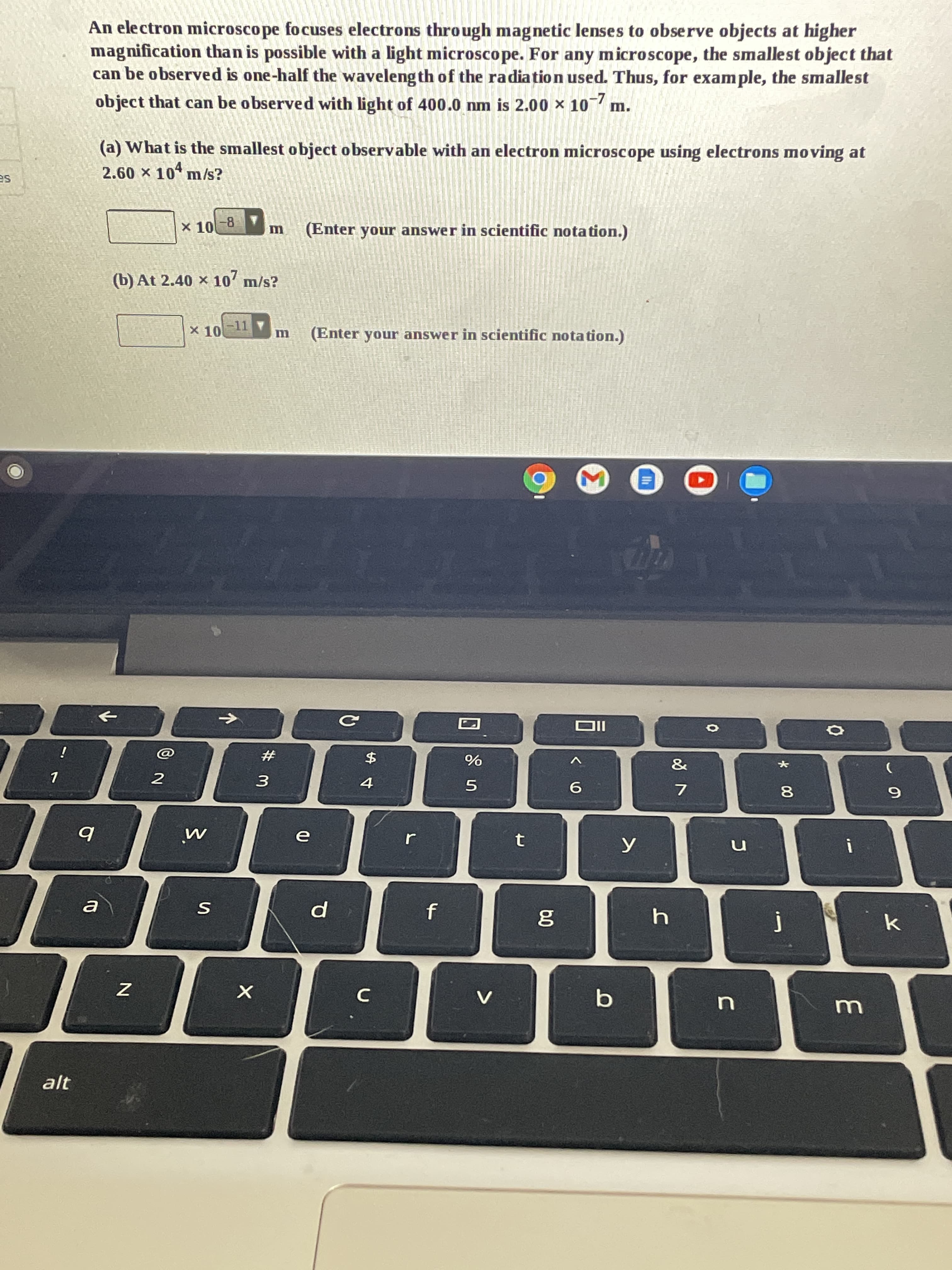* 00 $寸 An electron microscope focuses electrons through magnetic lenses to observe objects at higher magnification than is possible with a light microscope. For any microscope, the smallest object that can be observed is one-half the waveleng th of the radiation used. Thus, for example, the smallest object that can be observed with light of 400.0 nm is 2.00 x 10 m. (a) What is the smallest object observable with an electron microscope using electrons moving at 2.60 x 10 m/s? SE X 10-8 (Enter your answer in scientific notation.) (b) At 2.40 × 107 x 10 -11 (Enter your answer in scientific notation.) -> IIO i # & % 3. 9. 7. 61 alt
* 00 $寸 An electron microscope focuses electrons through magnetic lenses to observe objects at higher magnification than is possible with a light microscope. For any microscope, the smallest object that can be observed is one-half the waveleng th of the radiation used. Thus, for example, the smallest object that can be observed with light of 400.0 nm is 2.00 x 10 m. (a) What is the smallest object observable with an electron microscope using electrons moving at 2.60 x 10 m/s? SE X 10-8 (Enter your answer in scientific notation.) (b) At 2.40 × 107 x 10 -11 (Enter your answer in scientific notation.) -> IIO i # & % 3. 9. 7. 61 alt
Chemistry: The Molecular Science
5th Edition
ISBN:9781285199047
Author:John W. Moore, Conrad L. Stanitski
Publisher:John W. Moore, Conrad L. Stanitski
Chapter5: Electron Configurations And The Periodic Table
Section: Chapter Questions
Problem 5.ACP
Related questions
Question

Transcribed Image Text:* 00
$寸
An electron microscope focuses electrons through magnetic lenses to observe objects at higher
magnification than is possible with a light microscope. For any microscope, the smallest object that
can be observed is one-half the waveleng th of the radiation used. Thus, for example, the smallest
object that can be observed with light of 400.0 nm is 2.00 x 10 m.
(a) What is the smallest object observable with an electron microscope using electrons moving at
2.60 x 10 m/s?
SE
X 10-8
(Enter your answer in scientific notation.)
(b) At 2.40 × 107
x 10
-11
(Enter your answer in scientific notation.)
->
IIO
i
#
&
%
3.
9.
7.
61
alt
Expert Solution
This question has been solved!
Explore an expertly crafted, step-by-step solution for a thorough understanding of key concepts.
This is a popular solution!
Trending now
This is a popular solution!
Step by step
Solved in 2 steps with 1 images

Knowledge Booster
Learn more about
Need a deep-dive on the concept behind this application? Look no further. Learn more about this topic, chemistry and related others by exploring similar questions and additional content below.Recommended textbooks for you

Chemistry: The Molecular Science
Chemistry
ISBN:
9781285199047
Author:
John W. Moore, Conrad L. Stanitski
Publisher:
Cengage Learning


General Chemistry - Standalone book (MindTap Cour…
Chemistry
ISBN:
9781305580343
Author:
Steven D. Gammon, Ebbing, Darrell Ebbing, Steven D., Darrell; Gammon, Darrell Ebbing; Steven D. Gammon, Darrell D.; Gammon, Ebbing; Steven D. Gammon; Darrell
Publisher:
Cengage Learning

Chemistry: The Molecular Science
Chemistry
ISBN:
9781285199047
Author:
John W. Moore, Conrad L. Stanitski
Publisher:
Cengage Learning


General Chemistry - Standalone book (MindTap Cour…
Chemistry
ISBN:
9781305580343
Author:
Steven D. Gammon, Ebbing, Darrell Ebbing, Steven D., Darrell; Gammon, Darrell Ebbing; Steven D. Gammon, Darrell D.; Gammon, Ebbing; Steven D. Gammon; Darrell
Publisher:
Cengage Learning


Chemistry: Principles and Practice
Chemistry
ISBN:
9780534420123
Author:
Daniel L. Reger, Scott R. Goode, David W. Ball, Edward Mercer
Publisher:
Cengage Learning

Chemistry & Chemical Reactivity
Chemistry
ISBN:
9781133949640
Author:
John C. Kotz, Paul M. Treichel, John Townsend, David Treichel
Publisher:
Cengage Learning